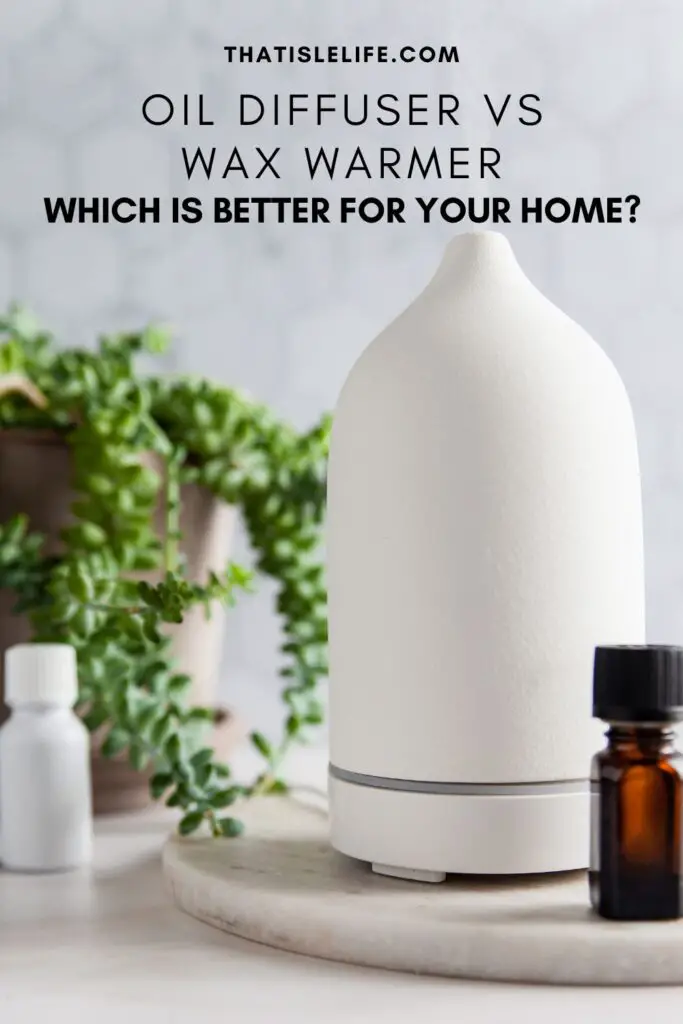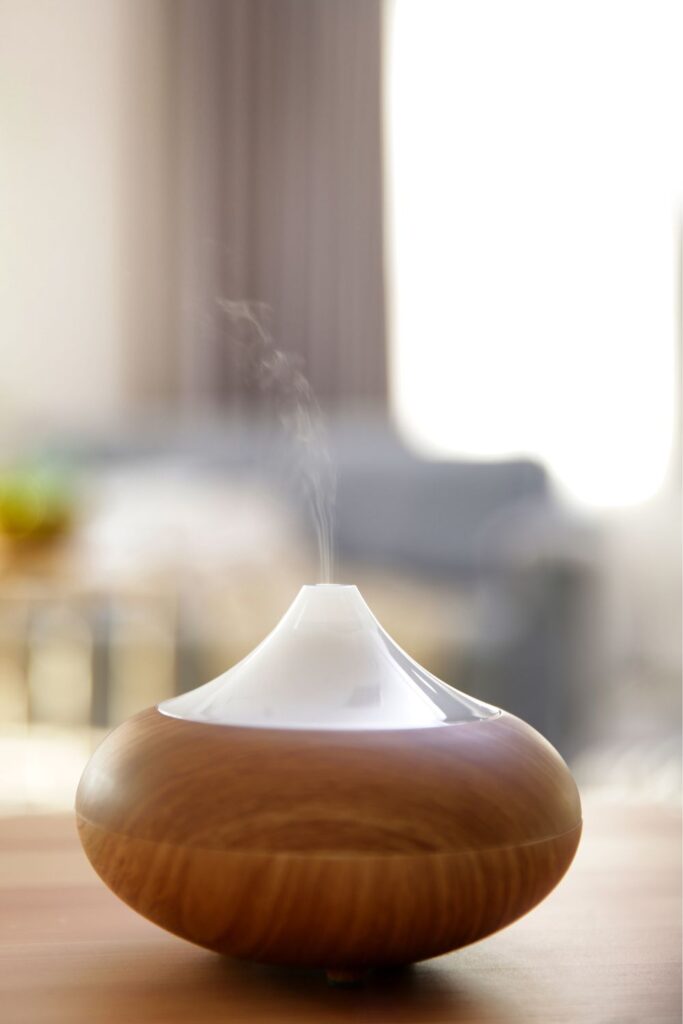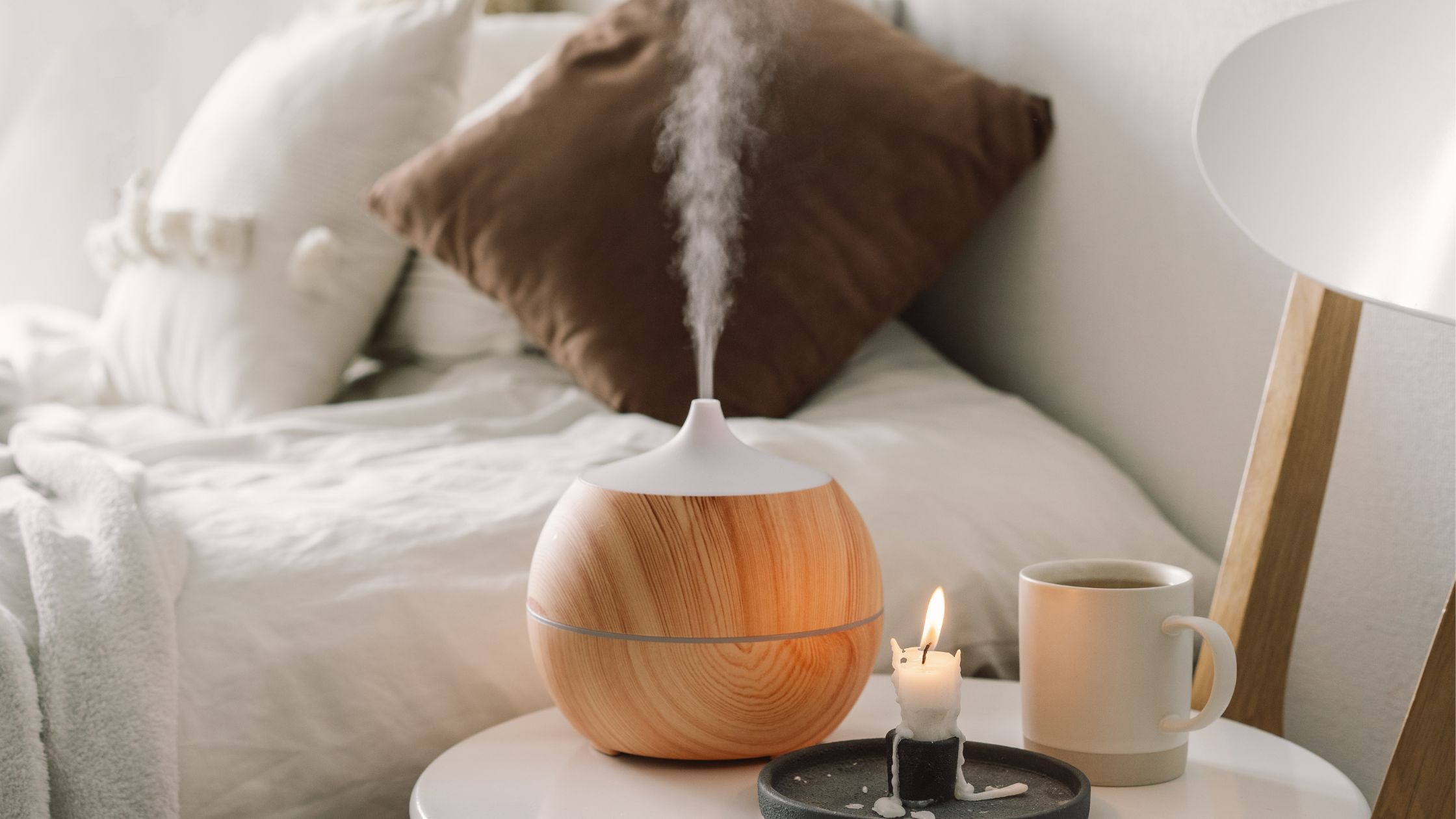Are you looking for a candle alternative but can’t decide between an oil diffuser vs wax warmer?
Maybe you’re looking for something you can leave on overnight without supervision because you want a long-lasting scent in your home.
Or maybe you’ve got your eye set on something affordable and low-maintenance because you like to switch fragrances.
Don’t worry, I’ve looked at both oil diffusers and wax warmers and I’ve included a comparison where you can discover which device is safer and more affordable.
You may even be surprised at which device gives off a more intense scent!
By the time you reach the end of this post, you don’t even have to look on Amazon. Click on one of my recommendations to enjoy your new soon-to-be favorite device.
Keep reading to learn the pros and cons of oil diffuser vs wax warmer, so you can pick the right device for your home!
Oil Diffuser vs Wax Warmer Summary
- What is an oil diffuser?
- Types of oil diffusers
- Pros and cons of oil diffusers
- Oil diffuser recommendations
- What is a wax warmer?
- Types of wax warmers
- Pros and cons of wax warmers
- Wax warmer recommendations
- Similarities between oil diffusers and wax warmers
- Comparison between oil diffuser vs wax warmer

Related: Reed Diffuser vs Candle – Which Is The Better Option For Your Home?
*Disclosure: This post may contain affiliate links that are at no additional cost to you, and I may earn a small commission if you purchase any products via my links. I only recommend products that I would use myself, and all opinions expressed here are my own. Read the full privacy policy here.
Oil diffuser

An oil diffuser is a device that fills the air in a room with tiny particles of essential oils.
All you have to do is add a few drops of your favorite essential oil (or essential oil blend) to a diffuser and you’ll be able to enjoy a continuous stream of a pleasant and relaxing scent that is not overpowering.
With five main types of oil diffusers in the market, you may be confused and wonder which is most suitable for you.
Fret not, here’s a breakdown of the five most commonly used oil diffusers. Let’s take a look at how each diffuser works and its pros and cons.
Types of oil diffusers
Reed diffuser
On the hunt for a safe and low-maintenance diffuser? Then the reed diffuser is for you.
Reed sticks are placed in a long-necked glass bottle that’s filled with essential oils. The reed sticks soak up the oil and disperse the molecules into the air.
Reed diffusers are easy to access and use, but they have limited reach. You’ll also need to consistently flip the reeds to maintain the scent.
Ultrasonic or humidifying diffuser
The ultrasonic diffuser is a popular option for many households.
It disperses essential oils into the air without the use of heat or a fan. It uses ultrasonic frequency instead, which is caused by vibrations from a small plate that is submerged in water in the diffuser.
All you have to do is pour a few drops of essential oil into the water. The result is a cool mist that distributes the oil molecules, scenting your home with the essential oil of your choice.
A lot of people often confuse the mist with steam, but this is wrong since the ultrasonic diffuser doesn’t use heat.
Since heat is not present, it is an ideal choice for families with children and pets.
Besides that, ultrasonic diffusers double up as humidifiers. Just fill the diffuser with water (no essential oil needed!) and let it run to add moisture to the air.
The downside to an ultrasonic diffuser is that some essential oils that contain acid can erode parts of the diffuser since the diffuser is made of plastic. Always clean your diffuser after using it.
Nebulizing diffuser
Nebulizing diffusers do not use water, heat, or a fan.
All you have to do is add a small amount of undiluted essential oil to the device’s reservoir.
Some devices have no reservoir, so you can screw the bottle of essential oil directly into the device.
Besides a reservoir, the device has an air pump on top of a small tube above the reservoir.
The air pump blows air across the top of the tube, which creates a vacuum that pulls oil to the surface and disperses scent into the air.
The nebulizing diffuser disperses essential oils quickly and at a much higher concentration than other diffusers.
This means it can quickly fill a large room with a strong scent. Nebulizing diffusers are also plastic-free.
These are the main reasons why some people will choose this diffuser over the ultrasonic diffuser.
However, nebulizing diffusers go through a lot more essential oil compared to the other diffusers.
Therefore, they are not as budget-friendly since you’ll probably have to buy more essential oils if you’re constantly using your device.
Pro Tip: Not all essential oils can be used in your nebulizing diffuser! Some essential oils are blended specifically for ultrasonic diffusers, so always read the label and check that you’re purchasing the right oil for your device.
Evaporative diffuser
Evaporative diffusers use a fan to generate wind, which causes the oil to evaporate.
First, the essential oil soaks into an absorbent material like a pad or a lining.
Then, wind from the fan flows through the lining causing the oil to evaporate, thus dispersing the scent into the air.
The evaporative diffuser is generally safe and fuss-free, but the scent typically doesn’t last long. You’ll also need to replenish new pads or linings in addition to the essential oils.
Heat or electric diffuser
As its name implies, this diffuser uses heat (primarily electric) to heat essential oils till they reach a point of evaporation.
Common heat diffusers include electric heat diffusers, candle diffusers, and lamp ring diffusers.
While a heat diffuser can offer a stronger scent, this doesn’t mean it’s a good thing.
The chemical composition of an essential oil can change under high heat. As a result, the aromatherapy benefits of the essential oil may change as well.
It is advisable to find a heat diffuser that works at consistent and low temperatures.
Pros of oil diffusers
- Many different types to choose from
- Comes in many designs and various price points
- Fills the room with scents
- Helps you to enjoy the aromatherapy benefits of essential oils e.g. relieving anxiety, aiding congestion, boosting moods, etc
- Chemical-free
- Some diffusers are safe to use overnight e.g. reed diffusers and nebulizing diffusers
Cons of oil diffusers
- Can be pricey
- Some devices do not provide long-lasting scents
- Small diffusers have limited scent reach and can’t fill a large room
- Heat or electric diffusers can damage oils
- Can possibly cause toxic mold
- Some devices are hard to clean
- Water and essential oil ratios can be tricky to remember
Oil diffuser recommendations
1. VIVITEST Ceramic Ultrasonic Essential Oil Diffuser
- Ultra quiet
- Looks beautiful
- Large capacity (250ml)
- 9 colors and 4 timers
- Has a long run time of 6-8 hours
- Comes with auto-off function
- One-year warranty
- Great customer service
- May not last more than a year (if this happens to you, leave a review or contact their customer service and you may receive a free replacement!)
- Comes with a one-year warranty
- Comes with 4 timers and 9 light color adjustments
- Waterless auto-off function available
- An aesthetic piece that doubles up as home decor
2. ASAKUKI Ultrasonic Essential Oil Diffuser with Remote Control
- #1 bestseller on Amazon (4.5/5 stars with over 50,000 ratings!)
- Comes with a two-year technical support
- Large tank capacity with auto-off function and ultra-quiet fan
- Comes with a convenient remote control
3. NEST Fragrances Reed Diffuser in Birchwood Pine
- Alcohol-free fragrance oils release scent for approximately 90 days
- Plastic-free and comes with all-natural reed sticks
- Option to purchase refills
Related: How To Make Your House Smell Like A Spa With 10 Simple Tips
Wax warmers

Wax warmers are not diffusers.
Think of them as an eco-friendly substitute for candles. That’s because they are used to heat wax melts, which are basically candle wax without a glass container and a wick.
All you have to do is place the wax melt of your choice on top of the wax warmer. You’ll start to smell a pleasant aroma once the wax melts.
There are four different types of wax warmers. Let’s study the differences and the pros and cons to determine the perfect wax warmer for you.
Types of wax warmers
Tea light warmer
This is a traditional wax warmer that does not require the use of electricity. A tea light warmer uses a tea light to melt the wax.
Since it’s an open flame, the fragrance from tea light warmers is usually stronger.
However, this means the wax also melts quickly and you’ll have to keep topping up the wax melts if you want the scent to last.
A tea light wax warmer is probably the cheapest option, but it is also the most dangerous.
Since a candle is involved, it should be attended to at all times. It must also be placed on a heat-proof surface.
Pro Tip: Use unscented tea light candles to get the purest fragrance from your wax melts.
Electric wax warmer
A safer alternative to the tea light warmer is the electric wax warmer.
Instead of an open flame, this warmer uses a light bulb for heat to melt the wax. Most electric wax warmers need to be plugged into a socket.
When it comes to electric warmers, there are three main components: dish, light bulb, and wattage.
Dishes are usually removable and made of glass or ceramic for easy cleaning.
For bulbs, either a halogen or incandescent bulb is used. The bulb may need to be changed from time to time.
It’s incredibly important to take note of wattage.
If the wattage is too low, the wax won’t fully melt to release the scent. On the other hand, a super high wattage can become dangerous.
If your electric warmer isn’t melting the wax properly, do not change your bulb to a higher wattage without checking the maximum wattage of your warmer.
This information is usually indicated on the packaging or a label underneath your warmer.
Overall, electric wax warmers offer a more consistent heat thus the scent is released for a longer period of time.
Pro Tip: Did you know different wax melts have different melting points? Check with your retailer before you purchase your wax melts to get the right ones for your warmer.
Hot plate warmer
A hot plate warmer functions like an electric wax warmer except a bulb is not used. Instead, a heated plate is used to hold the dish containing wax melts.
You don’t have to worry about changing a light bulb if you have a hot plate warmer.
Furthermore, they are usually low wattage, thus they are able to offer a more consistent heat, which makes for a more balanced and long-lasting fragrance.
However, they don’t look as aesthetic as electric wax warmers. They are bulky and tend to take up more counter or table space.
Plug-in warmer
Plug-in wax warmers use electricity, but they have no cables and go straight into the socket.
They are relatively affordable and convenient to use, especially in small homes.
One drawback of a plug-in warmer is that they have very low wattage.
As a result, they may not be able to melt wax quickly. They should also be placed in low-traffic areas and in higher kitchen sockets where children and pets are unable to reach them.
Pros of wax warmers
- Wax melts come in many colors, designs, and scents
- Affordable
- Fills the room with scents
- Helps you to enjoy the aromatherapy benefits of essential oils e.g. relieving anxiety, aiding congestion, boosting moods, etc
- Easy to change fragrance
- Ability to customize your own scents (by melting and mixing different wax melts)
- No complicated essential oil and water ratios to remember
Cons of wax warmers
- Tea light wax warmers use an open flame, which can be dangerous
- Heat can destroy the benefits of your wax melt if it contains essential oils
- Some wax melts may contain chemicals
- Can’t be left overnight as they require heat or electricity
- Can be a little messy
- Scents tend to be concentrated in one area instead of filling the entire room
Wax warmer recommendations
1. CANDLE WARMERS ETC 2-in-1 Candle and Fragrance Warmer
- Can be used for wax melts and candles
- Comes with a one-year warranty
- Beautiful design
2. Bobolyn Ceramic Electric Wax Warmer
- Comes with a carved halo pattern that illuminates the environment with a starry sky illusion
- Uses a halogen light bulb
- Comes with a deep wax dish to accommodate more wax melts
- Great value for money
3. Bobolyn Electric Wax Warmer
- Works for both wax melts and candles
- Uses iron plate heating
- Simple and minimal design
- Suitable for small spaces
Related: How To Make Your House Smell Like A Hotel In 9 Simple Steps
Similarities between oil diffusers and wax warmers

Oil diffusers and wax warmers share a few similarities:
- A wide variety to choose from
- Both devices are compatible with essential oils, which offer plenty of aromatherapy benefits
- Some devices use heat or electricity, which can reduce the health benefits of essential oils
Comparison between oil diffuser vs wax warmer

Now that you’ve read about the pros and cons, let’s check out the comparison between oil diffuser vs wax warmer.
Long-lasting scent
Winner: Oil diffuser
Unlike wax warmers, there are some oil diffusers that can be left overnight without any supervision. So, the oil diffuser wins hands-down when it comes to offering long-lasting scents.
Scent intensity
Winner: Wax warmer
Wax melts typically have a stronger throw. But, the scent tends to be more concentrated in one area instead of filling the entire room.
Ability to change fragrance easily
Winner: Wax warmer
Since wax melts are so affordable, you can easily switch to a new fragrance by simply using a new wax melt. Conversely, oil diffusers only take essential oils, and these are usually more expensive. If you have an ultrasonic diffuser, it may take a while to finish one bottle of essential oil since only a few drops of essential oil are needed.
Safety
Winner: Oil diffuser
All wax warmers require either heat or electricity to function. On the contrary, you can opt for heat and electricity-free diffusers such as reed diffusers or nebulizing diffusers. These two diffusers are flameless, so they can be used at any time without supervision.
Affordability
Winner: Wax warmer
Generally, oil diffusers cost more than wax warmers. Besides the device itself, oil diffusers require more money in the long run because essential oils are more pricey compared to wax melts.
Ambiance
Winner: Wax warmer
Although many diffusers now come with LED lights, nothing can beat the cozy glow of a flickering tea light.
Frequently Asked Questions
Can you sleep with a wax warmer on?
No, it is not advisable to sleep with a wax warmer on. It’s important not to leave a wax melt warmer unattended at all times because this can lead to potential fire hazards.
How many times can you reuse wax melts?
You can reuse your wax melts until the fragrance is gone. I recommend using only high-quality, all-natural, and non-toxic wax melts.
Conclusion
If you ask me, I can’t choose between the oil diffuser or wax warmer.
I guess that explains why I have an ultrasonic diffuser in my bedroom, reed diffusers in my bathroom, and a tea light wax warmer in my kitchen.
I like using the ultrasonic diffuser in my bedroom because I can also use it as a humidifier.
It also has an auto-off function, which is great because I can leave it on overnight without worrying about causing an accidental fire.
I love placing reed diffusers in my bathrooms – not only do they smell great in small spaces, but they literally require zero maintenance.
The tea light wax warmer works well in my kitchen because I can keep an eye on it while I’m cooking. And, it gives me an opportunity to use all of the wax remnants I have from my candles.
So, what’s your pick? Are you team oil diffuser or team wax warmer? Let me know in the comments below!








3 Comments